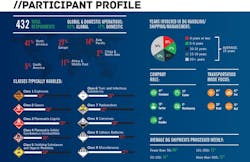Labelmaster’s DG survey reveals hazmat transport issues, more
Labelmaster, a provider of products, services and technology for the safe and compliant transport of dangerous goods (DG) and hazardous materials (hazmat), recently released the results of its annual 2019 Global Dangerous Goods Confidence Outlook.
Sponsored by Labelmaster, International Air Transport Association (IATA) and Hazardous Cargo Bulletin, the fourth annual survey was conducted to gain insight into how organizations around the globe approach DG shipping and handling, and the challenges they face.
Findings were presented on Sept 4 at the 2019 Dangerous Goods Symposium in Chicago IL.
“The growth of e-commerce and the evolution of supply chain has made moving dangerous goods in a safe and compliant manner more important than ever,” said Robert Finn, vice president of Labelmaster. “Unfortunately, several key gaps exist within organizations’ processes and infrastructure that make maintaining a compliant and reliable hazmat supply chain challenging.”
Key Findings from the Report
The survey results found that DG pros around the globe continue to find compliance challenging and time-consuming and desire additional support from their companies in order to better ensure compliance, support future operational needs and gain greater business value from the supply chain. Overall, budget constraints, lack of adequate technology, lack of senior-level executive risk awareness and resource constraints all contribute to this feeling. According to the survey:
- While 66% of DG pros feel confident that the investment their company makes to support DG compliance can meet current needs, 21% indicated it does not meet current needs. Only 13% believe their current investment can support future needs.
- 71% of DG pros believe their supply chain adds positive economic impact to their business.
- 56% do not believe that (or are unsure if) their supply chains are a differentiator for their companies.
Gaps in the Supply Chain
The lack of confidence many DG pros have in their organization’s supply chains is, in part, the result of specific gaps within their operations and infrastructure. These gaps include their ability to handle growing reverse logistics needs, access to complete and reliable master data, technology with adequate DG functionality, and compliance of their partners and carriers.
- 67% of respondents feel their company’s reverse logistics processes for DG are adequate to meet current needs, while 13% indicate they are not adequate to meet current needs. Only 20% feel they can support future requirements.
- 45% of companies have problems with centrally collecting, storing and communicating key hazmat data, and 55% have problems getting high-quality, accurate data from upstream supply chain partners.
- 55% of DG pros still rely on manual processes for shipping DG.
- Only 29% said their ERP system possesses all of the DG supply chain functionality needed, while 41% said their WMS possesses all of the necessary DG functionality.
- 71% of respondents wish their supply chain partners were as compliant as their company.
- 42% of respondents agree that the carelessness with which carriers handle/transport DG is a significant problem for their business.
“Companies view DG management and compliance differently, which directly impacts their level of investment and, ultimately, their ability to ensure compliance across their entire organization and adapt to changing operational needs,” Finn said. “As a result, many organizations lack the resources needed to meet their current supply chain needs, and few have the budget and infrastructure necessary to support future requirements.
“In order to successfully navigate an increasingly complex and dynamic hazmat supply chain landscape, organizations need to think of compliance beyond simply a mandate and the threat of a fine, and recognize how it can be a competitive advantage that drives revenue, improves supply chain performance, reduces risk and enables better customer service.”
Labelmaster identified how three distinct organizational approaches to DG management influences the level of financial resources, support and compliance confidence. To learn more about these groups, the gaps that exist within the DG supply chain and ideas to change the DG discussion within an organization, download the full report at labelmaster.com/dg-confidence-outlook.


